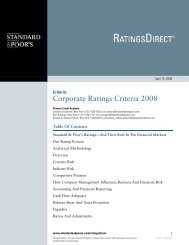European Infrastructure Finance Yearbook - Investing In Bonds ...
European Infrastructure Finance Yearbook - Investing In Bonds ...
European Infrastructure Finance Yearbook - Investing In Bonds ...
You also want an ePaper? Increase the reach of your titles
YUMPU automatically turns print PDFs into web optimized ePapers that Google loves.
Publication Date:<br />
June 13, 2007<br />
Issue Credit Rating:<br />
Senior secured debt<br />
BBB-; BBB-/Stable<br />
Primary Credit Analyst:<br />
Karim Nassif,<br />
London,<br />
(44) 20-7176-3677<br />
Secondary Credit Analyst:<br />
Alexandre de Lestrange,<br />
Paris,<br />
(33) 1-4420-7316<br />
AUTOROUTES PARIS-RHIN-RHONE<br />
Rationale<br />
The senior unsecured debt rating on the French<br />
toll road operator Autoroutes Paris-Rhin-Rhone’s<br />
(APRR) seven-year, €1.8 billion, revolving credit<br />
facility maturing in 2013 is ‘BBB-’. The outlook is<br />
stable. As of May 25, 2007, the facility had a<br />
utilization of €0.8 billion. At the same date, total<br />
debt was €6.4 billion.<br />
Since its privatization in 2006, APRR is<br />
81.48% owned by Eiffarie (not rated), a<br />
consortium controlled by Eiffage and Macquarie<br />
Autoroutes de France (MAF). The remaining<br />
shares are publicly held. Total debt at Eiffarie as<br />
at May 25, 2007, is €3.9 billion. The APRR<br />
group includes both APRR and Eiffarie, which,<br />
because Eiffarie is an 81.48% shareholder, leads<br />
us to consolidate the debt of Eiffarie into APRR.<br />
We have fully consolidated Eiffarie’s debt and<br />
related interest expenses with those of APRR<br />
because we treat the two entities as one group for<br />
default analysis purposes. Eiffarie’s debt is<br />
nonrecourse to APRR.<br />
APRR is the third-largest toll-road operator in<br />
Europe, with a network of 2,215 kilometers (km;<br />
1,370 miles) in service and 2,279 km under<br />
concession until 2032. APRR group’s highway<br />
concession network is well located across central<br />
and eastern France, representing the major axes<br />
between the two wealthiest French regions, Ile-de-<br />
France (AAA/Stable/A-1+) and Rhône-Alpes, and<br />
the two largest French cities of Paris<br />
(AAA/Stable/--) and Lyon, as well as links to<br />
Benelux and Germany. APRR’s subsidiary AREA<br />
has the major road network connection to the<br />
Alps, related ski resorts, and Geneva, Switzerland.<br />
The network therefore comprises key economic<br />
and tourist corridors to southern France. No<br />
major new competing roads or transport links<br />
are expected.<br />
The revolving credit facility is sized to support<br />
about two years of capital expenditures, debt<br />
repayments to Caisse Nationale des Autoroutes<br />
(CNA; AAA/Stable/--), and working capital at<br />
APRR following its acquisition by Eiffarie.<br />
The ‘BBB-’ rating reflects the following risks:<br />
• APRR has an aggressive financial structure,<br />
with low debt service coverage levels and<br />
high consolidated leverage, taking into<br />
account total debt at APRR and Eiffarie.<br />
Standard & Poor’s Ratings Services’ base<br />
case assumes traffic growth of 1.75% over<br />
the life of the concession, with consolidated<br />
STANDARD & POOR’S EUROPEAN INFRASTRUCTURE FINANCE YEARBOOK<br />
PROJECT FINANCE/PUBLIC-PRIVATE PARTNERSHIPS<br />
minimum debt service coverage at 1.31x.<br />
This minimum occurs in 2012, based on an<br />
assumed refinancing of the Eiffarie debt in<br />
2011, and an assumed amortization profile<br />
post refinancing. Prior to the forecast<br />
refinancing, the minimum coverage ratio is<br />
1.42x. Although this is low compared with<br />
other rated highways projects with traffic<br />
risk, the maturity and large scale of APRR’s<br />
road network mitigate this.<br />
• The structure contains considerable<br />
refinancing risk, as significant debt amounts<br />
are due from CNA by 2018. We understand<br />
that APRR is currently looking at ways to<br />
refinance CNA obligations due in late 2007<br />
and beyond. APRR also has large capital<br />
expenditure requirements, and the Eiffarie<br />
acquisition facility has little amortization<br />
until it needs to be refinanced. Although the<br />
revolving credit facility, the strong cash flow<br />
generating ability over the life of the<br />
concession, and an increasing cash sweep in<br />
the acquisition facility mitigate refinancing<br />
risk, it remains higher than that of<br />
comparable investment-grade transactions.<br />
• Although Standard & Poor’s takes a<br />
concession financing approach to APRR, we<br />
regard the overall structural package, with<br />
regard to shareholder lock-in periods, as<br />
weaker than those of comparable<br />
investment-grade concessions. The<br />
privatization process resulted in lock-in<br />
requirements for Macquarie and Eiffage of<br />
two and 10 years, respectively. Given the<br />
importance of retaining two balanced<br />
shareholders in the structure, the absence of<br />
further structural mitigants to prevent the<br />
emergence of a dominant shareholder<br />
remains a key structural weakness.<br />
• Traffic growth was weak in 2006, but has<br />
shown recovery in the first quarter of 2007.<br />
Traffic growth reported for 2006 at 1.3%<br />
was below what we considered to be a<br />
conservative assumption of 1.75% traffic<br />
growth under our base case. Nevertheless,<br />
although traffic growth has been low and is<br />
not expected to improve substantially over<br />
the short term, revenues have met budgeted<br />
targets and are expected to continue to do<br />
so going forward.<br />
• Although about 95% of all debt at Eiffarie<br />
and APRR is hedged, the structure remains<br />
NOVEMBER 2007 ■ 133



